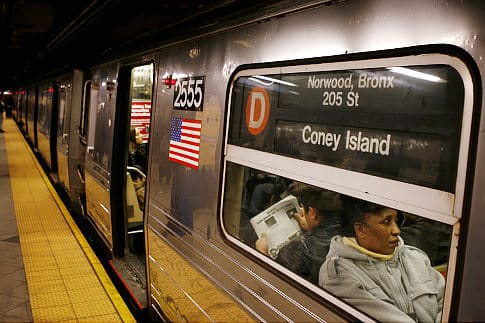New Yorkers generally get a bad rap. Their ironclad image: rude, aggressive, and self-centered. The stereotype may be valid to a certain degree, but often it’s also a façade. I recently witnessed the façade break on a crowded subway.
The minute I stepped into the D train during morning rush hour at Columbus Circle, I knew I needed to grab my New Yorker magazine. The subway car was packed with middle school students – rough, rowdy, and pushy. I looked around and there were more than 100 of them, with three teachers yelling for them to calm down. These students were on the way to see the famous Christmas tree at Rockefeller Plaza.
I tried to seek mental escape from the noise and commotion by diving into reading my magazine, but I was abruptly jolted back to reality when the D train suddenly stopped: we’re stuck.
A woman, all bundled up in her wool hat and scarf, burst into panic. She started huffing and puffing and removing her clothing from head to neck.
“Oh no, oh no, I’m going to faint. I can’t handle this; I’m having a panic attack.”
Her face started turning white, her lips parched. The group of 9-year-olds around her looked up at her, transfixed.
Next, we heard an overhead announcement, “Due to a crowd issue on another train, we’ll be stalled in the station for about five minutes.”
“Oh no, this can’t happen! I need to get out!!” As she started acting out her claustrophobic mania, the train conductor unexpectedly opened the door behind her.
“It’s okay ma’am. It’s only five minutes. We are safe,” said the chubby conductor with a bulge in the belly. He looked like the “Subway Santa” we need in a time of confusion.
“You don’t understand, you have to get me out of here. I don’t have my medications. I’m having a panic attack! How long will this be? Promise me, take me out now!”
She began to fan her face and chest in nervous jitters. I reached out to touch her forearm, “Ma’am… You’re fine, really, you can do this. Look at these kids, they can give you a seat.”
These previously rough and rowdy kids were suddenly as still as stone; cracking their sweet smiles as they saw strangers helping a stranger.
“Ma’am, this won’t take long. You are fine,” the conductor chimed in.
“That’s right, it could be worse. We have light, we can breathe,” another woman jumped in.
“Are you going to share your lunch with this lady?” I tried to crack a joke with the children clutching their lunch bags. The kids answered with a shrug, the panicky woman started calming down a little.
Over the next 10 minutes, the Subway Santa kept coming back to check on her – “Ma’am, you’re okay, right? You’re going to make it, right?”
Soon our train started moving!
“Wow – ho-ho-ho” the Subway Santa came back with a big smile.
When we reached the next station, all the kids marched out in an orderly fashion. In a matter of seconds, our subway car was nearly empty; the previously panicky woman decided to sit down. She gave me a long look while taking in a deep breath, “Finally. I can relax.”
“It’s a nice day out today. Enjoy!” I smiled at her.
Her face lit up, “Thank you. Have a nice day; God bless you.”
I realized how all New Yorkers could begin the day minding their own business, but quickly break the façade in times of common emergencies. This type of behavior is exactly the essence of the meaning behind this Chinese phrase “患难见真情.” Loosely translated it means authentic compassionate sentiments emerge from common crisis. On this day, I witnessed 患难见真情 among “hard-shell” New Yorkers, who are truly not “hard-core” at heart.纽约客总是配搭着一串糟糕的评价。他们有着鲜明的形象:粗鲁的、
早高峰的时候,当我在哥伦布圆环站踏进D车的那一刻,
我翻开杂志,努力使我的注意力分散,不受这嘈杂喧闹环境的影响。
一位包裹着羊毛帽子和围巾的女士开始陷入恐慌。她开始变得愤怒,
“哦不,哦不,我要晕了。我忍不了这样;我的急性焦虑症发作了。
她开始脸色发白、嘴唇干透。一群9岁的孩子在她周围,
接着,我们听见头顶的广播,“由于另一辆车的拥挤问题,
“哦不,这可不行。我得出去!”她开始表现出狂躁症,
”没事的,女士,仅仅5分钟而已。我们很安全。”
“你不能理解,你必须让我从这里出去,我没有带药,
她开始给自己的脸和胸扇风,身体紧张地抖动着。我走近她,
这些之前又吵又闹的孩子们突然变得像石头一样安静;
“女士,这用不了多久的。你没事的。”列车员插嘴道。
“是的,即便再糟也不怕。我们有灯,我们能呼吸。”
“你们愿意与这位女士一起分享你的午餐吗?”
在之后的十分钟,那位地铁圣诞老人时不时地回来看看她,“女士,
很快,我们的车开始动了!
“啊哈哈哈”地铁圣诞老人回来给了一个大大的微笑。
当我们到达下一站,所有的孩子们秩序井然地走出车厢。瞬间,
“今天很适宜出门。享受吧!”我对着她笑笑。
她的脸色开始转好,“谢谢,祝你有美好的一天,愿上帝保佑你。”
我意识到纽约客们可以在每天刚开始的时候一心关注他们的工作,


